My Star Trek Writing
A Blast From the Past
I wrote this is July of 2012, eleven years ago. I had been indie publishing my own stuff for three years at that point and WMG had become a corporation in May of that year. I was solidly in my blog streak. So thought this would be interesting to bring forward just for historical perspective…
July 2012…
Last week in the mail I got this huge packet of royalty statements from Pocket Books. Now understand, when I say huge, I mean huge. Maybe 200 pages. I’ve written shorter novels to be honest.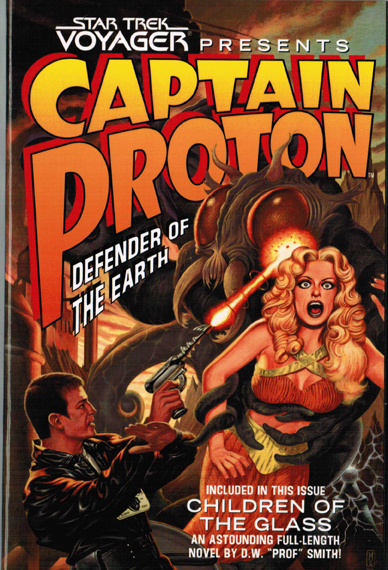
These statements are only for the books I did with Pocket Books that are still in print in one form or another. And a bunch of them are Star Trek books of one sort or another.
Looking through those statements, it reminded me that I got a letter recently from someone questioning my credits. This poor person could not believe that anyone could have written over a hundred novels and since I was lying about that, I couldn’t know anything about book pricing in indie. (Not kidding.)
Letters like that I just toss away and I did with that one. (I personally know writers who have produced three and four times the numbers of novels I have done. And for me, all it takes is a mild Google search under this name to find fifty or sixty of the novels I wrote, not counting all the pen name and ghost novel work.)
But the combination of that person’s silly letter and the Pocket Books royalty statement made me realize that it’s been a long, long time since I had a traditionally published book come out under a name that I could claim. So I figured that with a few posts over the next six months, I would take a group of the books I did and just talk about them for a few minutes.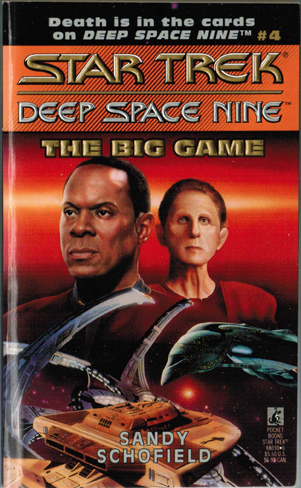
NOTE FROM 2023… I never did the other posts…
One group will be all the superhero books I wrote. Another group all the movie novelizations. Another group all the game novels. But first, tonight, since I was mostly known under this name as a Star Trek writer and editor (and the former publisher of Pulphouse Publishing Inc.), I figured I had to start with Star Trek books.
How Many Star Trek Books Did I Write or Edit?
I honestly don’t know or remember and am too lazy tonight to go try to figure out. I’m pretty sure the total is over thirty, but even a Google search won’t help on all of them since I did a few ghost novels in Star Trek.
For example, the Eric Kotani novel “Death of a Neutron Star” was supposed to be a complete ghost novel. But then about five years back a fan came up to me at a convention and asked me to sign it. I asked him why I would do that, since I hadn’t written it. (I actually had from a wonderful Eric Kotani idea and partial manuscript, but was under a non-disclosure agreement.) He said, “Your name is on the inside.” Sure enough, no one had bothered to tell me I was outed on that book.
Notice, all three images on the top of this post have pen names on them.
However, I can remember the first Star Trek novel Kristine Kathryn Rusch and I wrote very clearly. It was the deep winter of 1992 and Star Trek DS9 was about to start in early January of 1993. I had bought a story or two from John Ordover for Pulphouse Magazine and for some reason John and Kris were talking one night on the phone about another project. (Kris was editing The Magazine of Fantasy and Science Fiction.) John had just gone into the Pocket Books Star Trek department as an editor and his job was to revamp the program from mostly fan-written books to professional-written books. (Three editor/writers talking. Always fun.)
At the time we had a big backyard dish that picked up signals of programs before they aired, so we had seen the first episode of Star Trek: DS9 just the night before and way before it officially aired. Kris and John got talking about it. And one thing lead to another and John asked Kris if we would be interested in writing a book for the new series.
Yeah, duh. (The high school kid inside of me that used to go home instead of going out so I could watch Star Trek in the 1960s just about died at that moment.)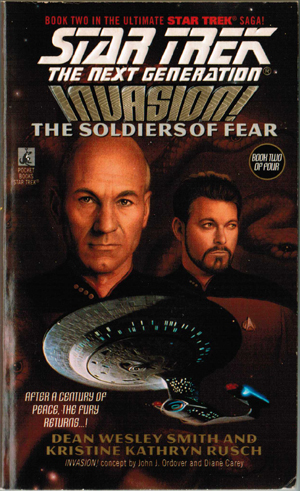
We were all afraid that six names would not fit on the cover, so Kris and I came up with the pen name Sandy Schofield and the novel “The Big Game” came out in 1993. (I can tell you from my royalty statements that so far it’s sold about 150,000 copies. Nice.)
From there Kris and I started doing more and more Star Trek novels together. I also did a bunch of Star Trek novels and projects on my own. A few I did on my own had Kris’s name on them, a few didn’t. And I ain’t saying which books those are.
Our bestselling Star Trek book was “Star Trek: Next Generation: Invasion: The Soldiers of Fear.” Part of the cross-over Invasion series between the four Star Trek series. That’s still selling like crazy and I don’t even want to mention how many copies that’s sold. It’s a ton. It also got Kris and I to #12 on the New York Times Bestseller official list when the list was only ten long. (The official list is now 15 spots long.)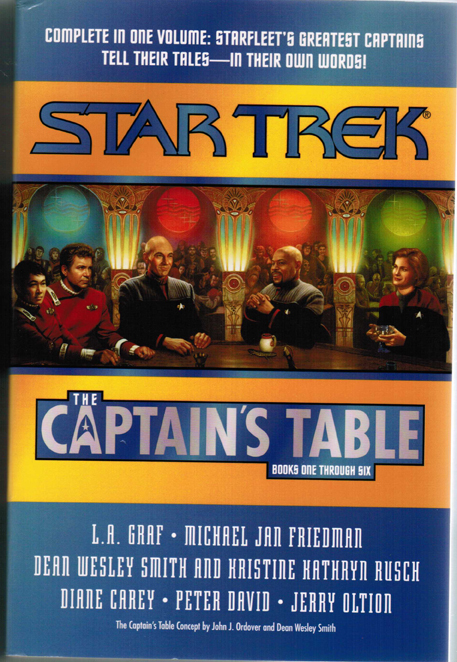
NOTE FROM 2023… Soldiers of Fear is still in print and selling past 1.7 million copies so far… One of the only Trek novels we still get checks for.
Along the way John Ordover and I came up with the idea for “The Captain’s Table.” That was basically a bar unstuck in time that any Starfleet captain could go to at any point on any planet. I designed the bar since I had been a bartender and came up with the cast of regulars. (Yes, we knew about Spider Robinson’s bar which rifted off of Arthur C. Clarke’s bar and so on back into time. And old sf idea brought to Star Trek.)
Kris and I did the Star Trek: DS9 book in this series. The jackets on each book had the captain on the front in the cover art and a bunch of people in the back. All the writers of the series were in the back, but not on our own books. Kris and I are standing behind Janeway’s right cheek bone. You have to get the Star Trek: Voyager book in the series to see us clearly.
Kris and I did a lot of books from 1993 to 2002 in Star Trek. We did the first original novel (writing the book only from a few scripts and still photos) for the Star Trek: Voyager series and then we did the first original novel again, way ahead of the airing, for Star Trek: Enterprise. That is a very, very scary thing to do considering how exacting to characters and details all Star Trek fans are. I’m pretty amazed to this day we got as close to the actual series as we did on both of those books, considering we were writing them before the first episodes were even filming.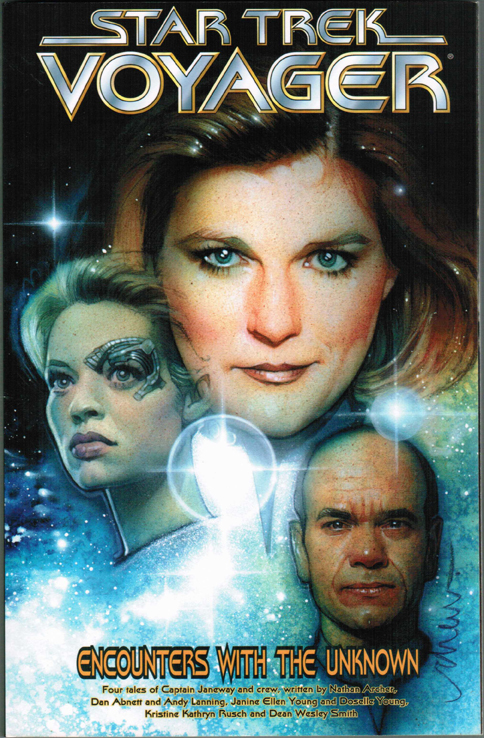
I also wrote the very first Star Fleet Core of Engineers novel for that series. It’s one of the longer books in the series.
As time went on, Kris and I also got to do some really fun stuff. We wrote a Star Trek comic book series for DC Comics under their Wildstorm imprint. Kris did the outline and I did the script since at the time she hadn’t read many comics. Thank heavens there was a good artist on my script because my script just wasn’t that good.
I got to write a few scripts for Paramount Pictures as well. One full-length feature film script turned out to be directed by Jonathan Frakes and was a live action game called “Klingon.” I ended up getting story credit since by that point I had no desire to join the Screen Writer’s Guild, let alone spend another moment in Hollywood. Then I turned around and novelized my own script for a paperback for Pocket Books. (A ton of money was made on that project.)
Of all the projects I did with Star Trek, three really stand out as being above and beyond fun. And two were from holodeck creations.
The first started the day John Ordover called me and asked me if I would like to do a “Captain Proton” book. (Picture of cover at the top of this post.) He called me because he knew of my love for the old pulps. On Star Trek :Voyager, one of the characters had created a great holodeck program featuring a Buck Rogers character called Captain Proton.
John’s idea was to put together a trade paper book in the form of the old pulp magazines, so under the name D.W. “Prof” Smith I wrote a short novel staring Captain Proton. (If you don’t get the pen name reference, let me just say I also wrote the entire short novel in that classic writer’s style.)
And then I also wrote three other pulp-style short stories for the book. One by Ray Hamil, one by Lester Lee, and one by Don Simster. (Of course all three stories were in the styles of the great old pulp writers that you should be able to figure out from my pen names.)
See why when someone asks me how many names I have published work under I have no idea. There are four pen names there. And no where on that book does it give Dean Wesley Smith as a name.
I also was allowed to write Captain Proton stories for Amazing Magazine and even had the cover of the magazine once.
The next fun project was the book Star Trek: The Next Generation: A Hard Rain. That novel stared Dixon Hill from the hard-boiled detective program on the holodeck. That was the hardest book I have written to date because it was a mystery in many sub-genres, set on a holodeck, while Picard could never be Picard, only Dixon Hill, and yet save the Enterprise.
Somewhere in the middle of all this John Ordover and I were trying to figure out how to get newer writers into Star Trek from the fan boards. The copyright issues were a nightmare. But finally John got the lawyers and his bosses and the fine folks at Paramount to agree to a contest and he called it “Star Trek: Strange New Worlds.”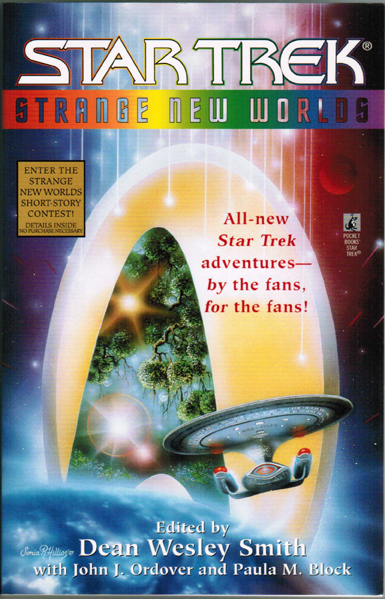
And he hired me. The third really amazing project I got to do with him.
I had been the publisher and one of the editors at Pulphouse Publishing Inc. and had edited Pulphouse Magazine for years. I had also been the fiction editor for VB Tech Journal for two plus years. I knew short fiction and I had written novels in every series, so John knew I loved all of Star Trek.
My job was to find 23 professional-level short stories from writers who had not professionally published more than three short stories or a novel. That’s right. My job was to find professional stories from beginning writers. Scared didn’t begin to describe how I felt about that task.
The first year the number of manuscripts was over 3,000 and I found 17 stories. The first book came out in 1998 and some writers in that book have gone to major writing careers, including Phaedra M. Wheldon, Dayton Ward, and Christina F. York.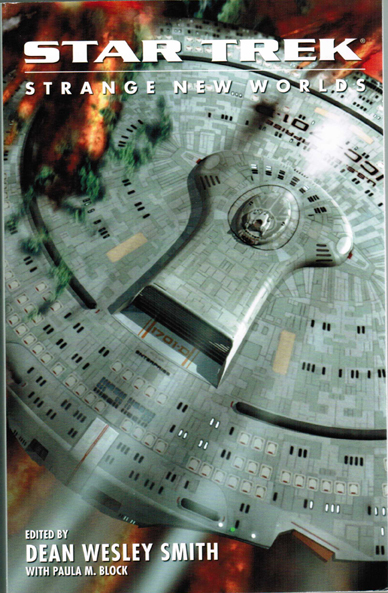
No one thought that the idea would go beyond the first year, but it just kept going even though Pocket Books lost a ton of money every year on the project. They did it for the fans. (Never happen in this world today. OR IN 2023)
For ten years, from 1997 to 2006 I put together a major collection of Star Trek short fiction. Every year I worried I would never find enough good stories, every year after the first year I had too many great stories to fit into the book.
That last volume of “Star Trek: Strange New Worlds” that came out in 2007 was the last thing I did with Star Trek. I had stopped writing novels for them in 2002 when John Ordover left editing, turning to my own novels and short fiction instead.
Summary
I wrote Star Trek novels in every series and outside of the series as well. And I edited for ten years with Star Trek. I had great fun working with the wonderful John Ordover and Paula Block at Paramount. I don’t miss Star Trek enough to go back to writing it, however, unless it is for a very special project.
NOTE: IN 2023 THAT WILL NEVER HAPPEN…
My Star Trek years were great fun. I was frighteningly lucky to have found my way into that program and become one of their go-to writers. The high school kid inside of me who used to hunger for every week’s new Original Star Trek episode in the 1960s still feels amazement he was allowed into the inner circle.
However, during those Star Trek years, I was doing a lot of other writing as well. I wrote novels in the superhero worlds of Spider-Man, X-Men, Iron-Man, and Superman. At least the ones I can claim. And a ton of movie novelizations including The 10th Kingdom with Kris. And even more gaming books. Plus a few originals as well.
Wow, have I had a great time writing or what?
6 Comments
Chris
Great post, Dean. I had not read that one before (been following you for several years now) so I’m pleased you reposted. My wife’s a Trekkie, and encouraged me to shake off my Star Wars roots. 😉
Philip
This reminds me of a ridiculous claim I saw on Reddit: “writing into the dark only works for media tie-in books because all the characters and setting have been established.” Talk about a myth-mongering moron.
Martin L. Shoemaker
I have an image of this Reddit commenter as Wile E. Coyote, running around screaming, “It’s not possible!” He runs off a cliff, looks down, sees that he’s out in the impossible gap, and falls.
Meanwhile Dean as the Roadrunner stands on the other side of the impossible gap, having done it. It’s not impossible if you do it.
Meep! Meep!
Jim Lawson
It took a little bit of searching, but I finally found my copy of the Voyager book of the Captain’s Table. I had no idea that was you and Kris on the cover. How cool!
I’m old enough to have watched the original series debut on NBC in 1966, and like you, I was hooked. I’m still amazed that Roddenberry was able to re-invent the show in the ’80s/’90s. I’m curious if you’ve kept up with the newer incarnations of the show, and whether you think they’ve managed to keep the spirit and philosophy of the original, or if they’ve changed to meet the changing times?
dwsmith
Jim, we watch them all. Third season of Picard was the best Trek ever done in my opinion. Second season the worst. Standard Trek.
Nathan Haines
This made me laugh! I liked Picard S1 for the story it ended up telling, not so much along the way. S2 was… well, interesting in its own way, I suppose, but not at all what interests me in Trek. S3 was overall pretty amazing for where it ended up. It’s fun when I agree with someone involved in the franchise, although more as a novelty (how anyone feels about any franchise is personal, after all).
I assumed that Strange New Worlds would be my favorite “new” Trek, and then Lower Decks came along and all the main characters had watched exactly as many episodes of Star Trek as I had (all of them) and then *that* was my favorite new Star Trek. And then Season 2 of Strange New Worlds came along and did a crossover episode with Lower Decks and I thought there was no way that could be a problem and then I found out Jonathan Frakes was going to direct it and I knew it’d be magic and it was.
Meanwhile, Star Trek: Prodigy was surprisingly really, really good. So while I haven’t loved everything in the last 5 years, there’s been plenty to be excited about, and isn’t that really more fun than complaining more than mildly about what I didn’t like?